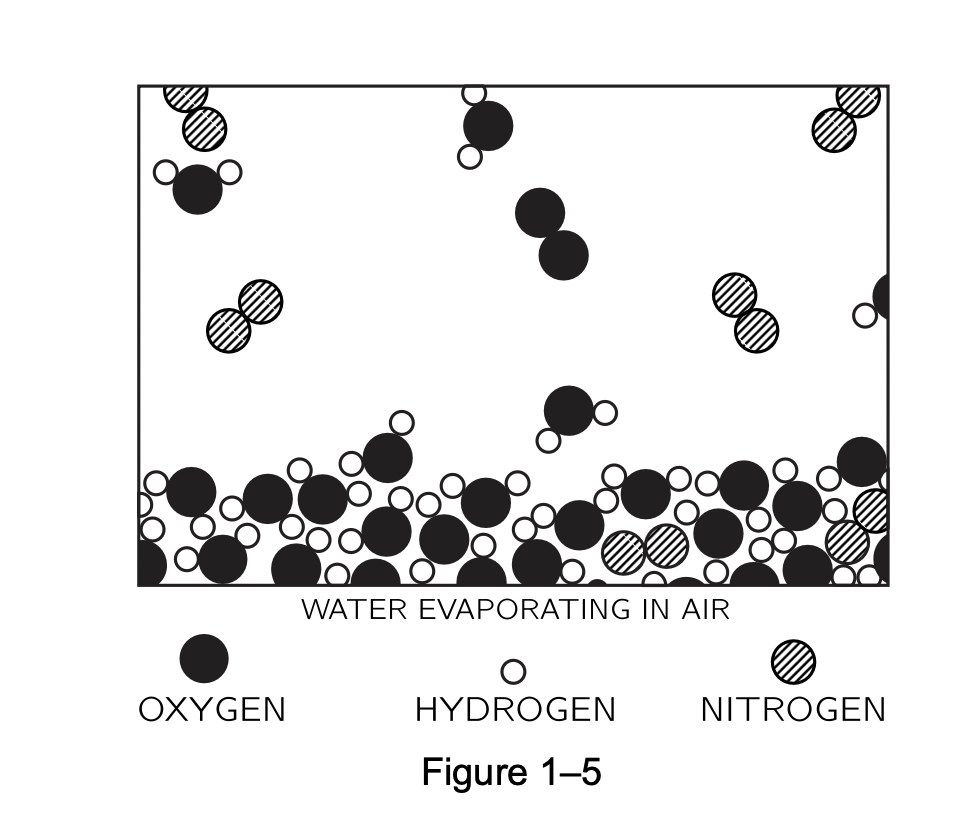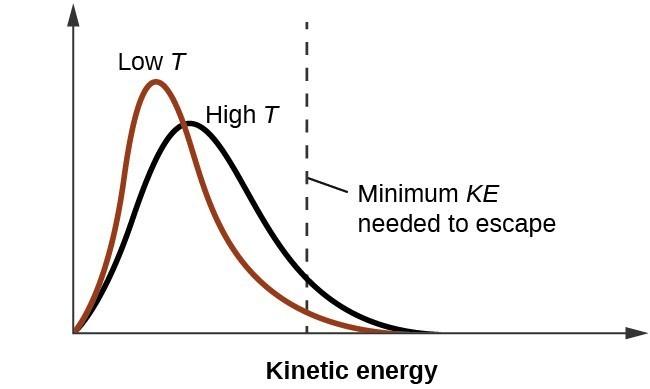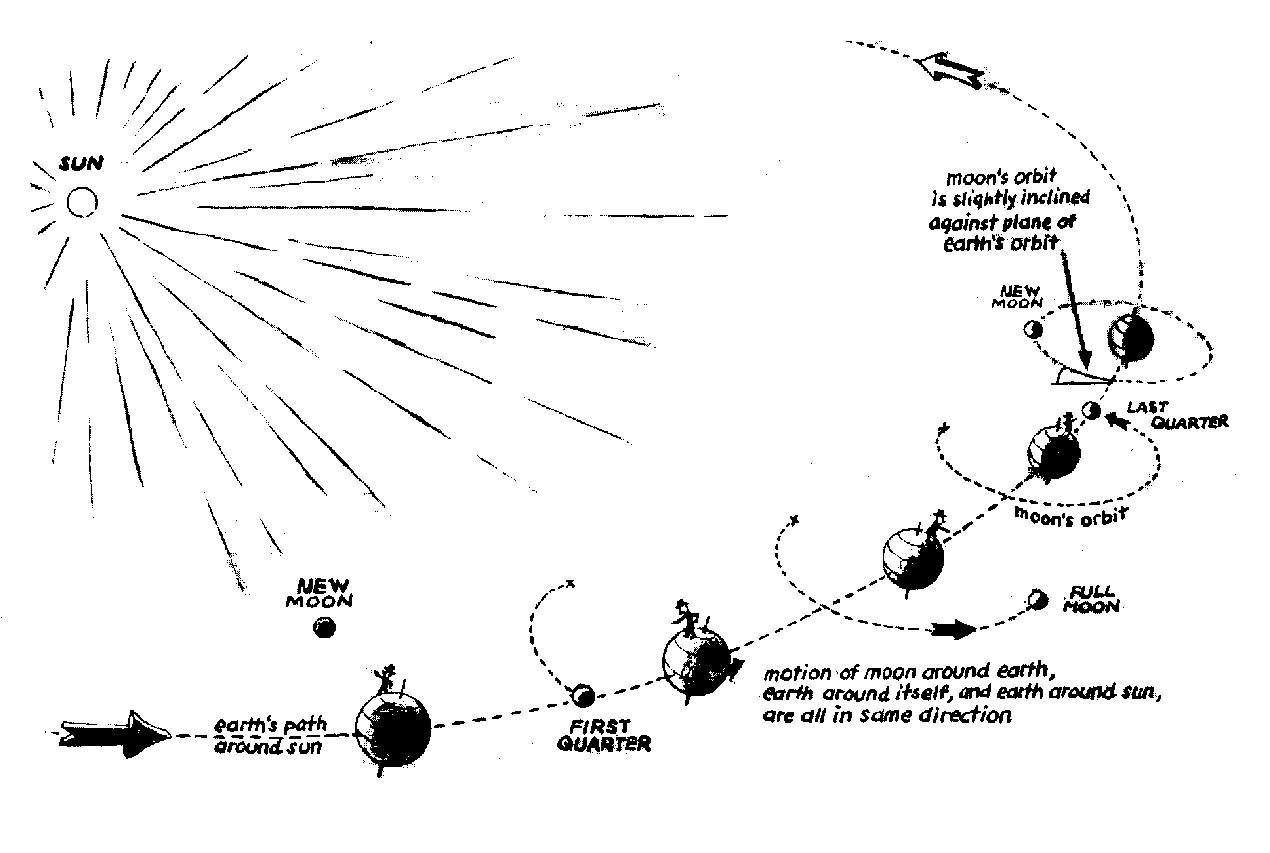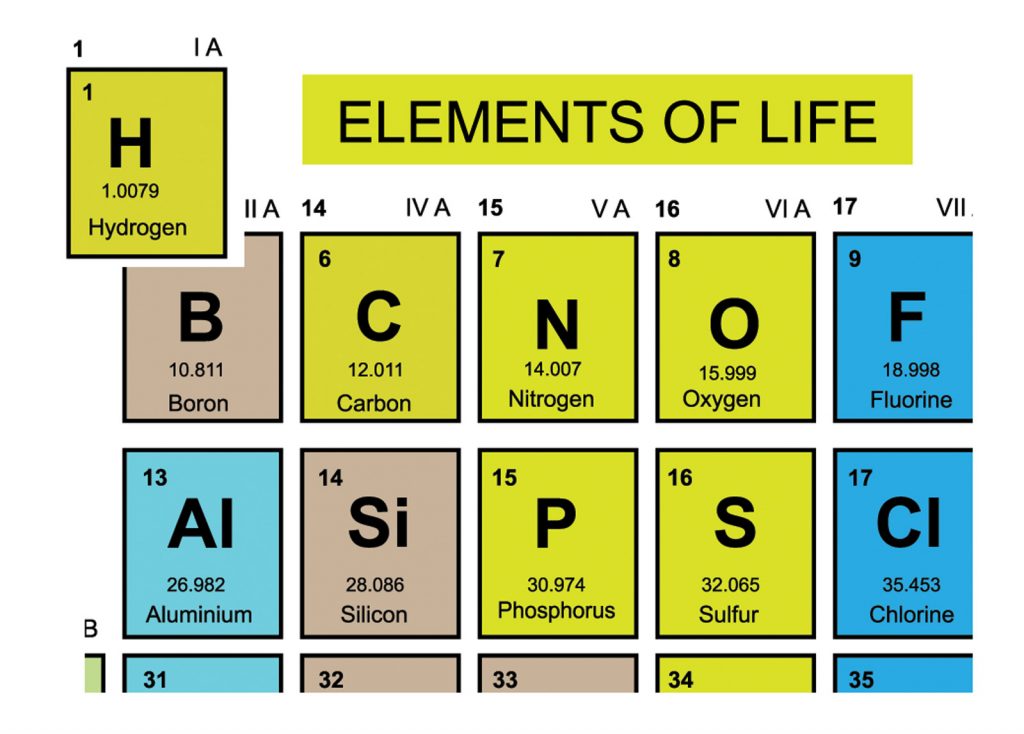How Does Life Come From Randomness? (2 min)
Kaplan_Life_Randomness.mp4
 Feynman Lectures On Physics
https://www.feynmanlectures.caltech.edu
Feynman Lecture No. 1 - Atoms in Motion
https://www.feynmanlectures.caltech.edu/I_01.html
Feynman Lectures On Physics
https://www.feynmanlectures.caltech.edu
Feynman Lecture No. 1 - Atoms in Motion
https://www.feynmanlectures.caltech.edu/I_01.html

 Attractive intermolecular forces are categorized into the
following types:
o Hydrogen bonding
o Ion-dipole forces and ion-induced dipole forces
o Van der Waals forces
Two important principles:
1. Evaporation: Cools the Water ==> Warms the Atmosphere
2. No evaporation takes place when the relative humidity
of the air is 100 percent (saturated)
Attractive intermolecular forces are categorized into the
following types:
o Hydrogen bonding
o Ion-dipole forces and ion-induced dipole forces
o Van der Waals forces
Two important principles:
1. Evaporation: Cools the Water ==> Warms the Atmosphere
2. No evaporation takes place when the relative humidity
of the air is 100 percent (saturated)
Energy Sources
 When stars form, gravitational collapse heats the shrinking
cloud of gas and dust to a high enough temperature (15
million Kelvin in the case of our Sun), that hydrogen nuclei
(protons) can overcome their repulsive Coulomb Force and
collide.
By the weak interaction in quantum mechanics, one of the
protons can be converted to a neutron, a positron, and a bit
of energy, in the form of an escaping neutrino. We detect
the solar neutrinos here on earth and measure their energy.
When stars form, gravitational collapse heats the shrinking
cloud of gas and dust to a high enough temperature (15
million Kelvin in the case of our Sun), that hydrogen nuclei
(protons) can overcome their repulsive Coulomb Force and
collide.
By the weak interaction in quantum mechanics, one of the
protons can be converted to a neutron, a positron, and a bit
of energy, in the form of an escaping neutrino. We detect
the solar neutrinos here on earth and measure their energy.
 The majority of the energy produced in stars like our sun
comes from the gamma photons produced when an additional
proton combines the proton-neutron pair to create light
helium ³He nuclei.
The energy sources for the earth are:
1. Radiation from the Sun (mostly visible light)
2. Internal heat from Radioactivity
3. Heat of formation (probably dissipated after 4.5 billion years)
4. Tidal Friction (from the gravitation of the Sun and Moon)
5. Impacts from solar system (asteroids, comets, meteoroids)
The majority of the energy produced in stars like our sun
comes from the gamma photons produced when an additional
proton combines the proton-neutron pair to create light
helium ³He nuclei.
The energy sources for the earth are:
1. Radiation from the Sun (mostly visible light)
2. Internal heat from Radioactivity
3. Heat of formation (probably dissipated after 4.5 billion years)
4. Tidal Friction (from the gravitation of the Sun and Moon)
5. Impacts from solar system (asteroids, comets, meteoroids)
Essential elements of Life
 List of interstellar and circumstellar molecules (212+)
https://en.wikipedia.org/wiki/List_of_interstellar_and_circumstellar_molecules
https://www.chemistryworld.com/features/the-surprising-organic-chemistry-in-interstellar-space/4019144.article
Thanks to advances in astronomical technology, we now know
there are ever-evolving regions where densities of matter
change, atomic clouds transform into molecular clouds that
collapse under gravity giving birth to protostars. More than
260 different molecular species have now been detected in
interstellar space, including alcohols, aldehydes, acids and
amides and many other organic molecules – some familiar on
Earth, some not stable here at all.
All of the bases in DNA and RNA have now been found in meteorites
https://www.sciencenews.org/article/all-of-the-bases-in-dna-and-rna-have-now-been-found-in-meteorites
List of interstellar and circumstellar molecules (212+)
https://en.wikipedia.org/wiki/List_of_interstellar_and_circumstellar_molecules
https://www.chemistryworld.com/features/the-surprising-organic-chemistry-in-interstellar-space/4019144.article
Thanks to advances in astronomical technology, we now know
there are ever-evolving regions where densities of matter
change, atomic clouds transform into molecular clouds that
collapse under gravity giving birth to protostars. More than
260 different molecular species have now been detected in
interstellar space, including alcohols, aldehydes, acids and
amides and many other organic molecules – some familiar on
Earth, some not stable here at all.
All of the bases in DNA and RNA have now been found in meteorites
https://www.sciencenews.org/article/all-of-the-bases-in-dna-and-rna-have-now-been-found-in-meteorites
Non-equilibrium thermodynamics
https://en.wikipedia.org/wiki/Non-equilibrium_thermodynamics
ORIGINS OF LIFE
First Support for a Physics Theory of Life
https://www.quantamagazine.org/first-support-for-a-physics-theory-of-life-20170726/
Non-equilibrium thermodynamics can help explain the creation
of increasingly complex molecules by describing how systems
far from equilibrium can evolve over time. In non-equilibrium
conditions, external energy inputs drive systems away from
thermodynamic equilibrium, allowing chemical reactions and
processes that would not normally occur in equilibrium states.
This can lead to the formation of complex structures,
including molecules, through processes like self-organization,
dissipative structures, and autocatalytic cycles. Such systems
can absorb energy and maintain a state of dynamic flux,
promoting reactions that create complexity.
However, while non-equilibrium thermodynamics provides a
framework, it doesn’t fully explain the emergence of molecular
complexity, which also depends on factors such as specific
chemical environments and reaction pathways.
Ribonucleic acid (RNA)
 A hairpin loop from a pre-mRNA. Highlighted are the
nucleobases (green) and the ribose-phosphate backbone
(blue). This is a single strand of RNA that folds back upon
itself.
A single strand of RNA that folds back upon itself forms
what is called a secondary structure. This folding is
significant for several reasons:
The folding of RNA helps stabilize the molecule, enabling it
to maintain its structure in the cellular environment. The
formation of double-stranded regions through base pairing
(typically between adenine and uracil, and between guanine
and cytosine) can provide stability to the RNA molecule.
Many RNAs, such as transfer RNA (tRNA) and ribosomal RNA
(rRNA), rely on their secondary structures to perform their
biological functions. For example, the cloverleaf structure
of tRNA is crucial for its role in protein synthesis.
The secondary structure of RNA can play a regulatory role in
gene expression. Some regions of mRNA form secondary
structures, such as hairpins or stem-loops, which can
influence the efficiency of translation by affecting how
ribosomes or regulatory proteins interact with the RNA.
Some RNA molecules, known as ribozymes, have catalytic
activity. The formation of specific secondary structures is
essential for the proper alignment of the active sites
required for these RNA molecules to perform enzymatic
reactions.
Many RNA viruses rely on specific secondary structures in
their RNA genomes for replication, translation, and evasion
of the host immune system. These folded RNA structures can
serve as recognition sites for viral proteins or host
factors.
Overall, the ability of RNA to fold into specific secondary
structures is crucial to its diverse roles in the cell, from
catalysis to regulation and gene expression.
A hairpin loop from a pre-mRNA. Highlighted are the
nucleobases (green) and the ribose-phosphate backbone
(blue). This is a single strand of RNA that folds back upon
itself.
A single strand of RNA that folds back upon itself forms
what is called a secondary structure. This folding is
significant for several reasons:
The folding of RNA helps stabilize the molecule, enabling it
to maintain its structure in the cellular environment. The
formation of double-stranded regions through base pairing
(typically between adenine and uracil, and between guanine
and cytosine) can provide stability to the RNA molecule.
Many RNAs, such as transfer RNA (tRNA) and ribosomal RNA
(rRNA), rely on their secondary structures to perform their
biological functions. For example, the cloverleaf structure
of tRNA is crucial for its role in protein synthesis.
The secondary structure of RNA can play a regulatory role in
gene expression. Some regions of mRNA form secondary
structures, such as hairpins or stem-loops, which can
influence the efficiency of translation by affecting how
ribosomes or regulatory proteins interact with the RNA.
Some RNA molecules, known as ribozymes, have catalytic
activity. The formation of specific secondary structures is
essential for the proper alignment of the active sites
required for these RNA molecules to perform enzymatic
reactions.
Many RNA viruses rely on specific secondary structures in
their RNA genomes for replication, translation, and evasion
of the host immune system. These folded RNA structures can
serve as recognition sites for viral proteins or host
factors.
Overall, the ability of RNA to fold into specific secondary
structures is crucial to its diverse roles in the cell, from
catalysis to regulation and gene expression.
Science News Media
The surprising organic chemistry in interstellar space
https://www.chemistryworld.com/features/the-surprising-organic-chemistry-in-interstellar-space/4019144.article
All of the bases in DNA and RNA have now been found in meteorites
https://www.sciencenews.org/article/all-of-the-bases-in-dna-and-rna-have-now-been-found-in-meteorites
Astronomers Discover Complex Carbon Molecules in Interstellar Space
https://www.sciencealert.com/astronomers-discover-complex-carbon-molecules-in-interstellar-space
First Look at Ryugu Asteroid Sample Reveals it is Organic-Rich
https://www.nasa.gov/centers-and-facilities/goddard/first-look-at-ryugu-asteroid-sample-reveals-it-is-organic-rich/
Scientists Discover RNA Component Buried in The Dust of an Asteroid
https://www.sciencealert.com/scientists-discover-rna-component-buried-in-the-dust-of-an-asteroid
https://www.nature.com/articles/s41467-022-29612-x
Never Before Detected – Organic Molecule Essential for Life Found in Interstellar Space
https://scitechdaily.com/never-before-detected-organic-molecule-essential-for-life-found-in-interstellar-space/
https://www.nature.com/articles/s41467-023-36904-3
Nonequilibrium Processes
https://sciurls.com/?btnG=sciurls&q=nonequilibrium
Researchers verify relationship between rate of a nonequilibrium process and the rate at which it creates entropy
https://phys.org/news/2022-02-rsearchers-relationship-nonequilibrium-entropy.html
Latest Science (all sciences)
http://edu-observatory.org/media/Science/index.html#LATEST
ChatGPT
https://chat.openai.com/chat
DuckDuckGo
Feynman Lectures On Physics https://www.feynmanlectures.caltech.edu Feynman Lecture No. 1 - Atoms in Motion https://www.feynmanlectures.caltech.edu/I_01.html

Attractive intermolecular forces are categorized into the following types: o Hydrogen bonding o Ion-dipole forces and ion-induced dipole forces o Van der Waals forces Two important principles: 1. Evaporation: Cools the Water ==> Warms the Atmosphere 2. No evaporation takes place when the relative humidity of the air is 100 percent (saturated)
When stars form, gravitational collapse heats the shrinking cloud of gas and dust to a high enough temperature (15 million Kelvin in the case of our Sun), that hydrogen nuclei (protons) can overcome their repulsive Coulomb Force and collide. By the weak interaction in quantum mechanics, one of the protons can be converted to a neutron, a positron, and a bit of energy, in the form of an escaping neutrino. We detect the solar neutrinos here on earth and measure their energy.
The majority of the energy produced in stars like our sun comes from the gamma photons produced when an additional proton combines the proton-neutron pair to create light helium ³He nuclei. The energy sources for the earth are: 1. Radiation from the Sun (mostly visible light) 2. Internal heat from Radioactivity 3. Heat of formation (probably dissipated after 4.5 billion years) 4. Tidal Friction (from the gravitation of the Sun and Moon) 5. Impacts from solar system (asteroids, comets, meteoroids)
List of interstellar and circumstellar molecules (212+) https://en.wikipedia.org/wiki/List_of_interstellar_and_circumstellar_molecules https://www.chemistryworld.com/features/the-surprising-organic-chemistry-in-interstellar-space/4019144.article Thanks to advances in astronomical technology, we now know there are ever-evolving regions where densities of matter change, atomic clouds transform into molecular clouds that collapse under gravity giving birth to protostars. More than 260 different molecular species have now been detected in interstellar space, including alcohols, aldehydes, acids and amides and many other organic molecules – some familiar on Earth, some not stable here at all. All of the bases in DNA and RNA have now been found in meteorites https://www.sciencenews.org/article/all-of-the-bases-in-dna-and-rna-have-now-been-found-in-meteorites
A hairpin loop from a pre-mRNA. Highlighted are the nucleobases (green) and the ribose-phosphate backbone (blue). This is a single strand of RNA that folds back upon itself. A single strand of RNA that folds back upon itself forms what is called a secondary structure. This folding is significant for several reasons: The folding of RNA helps stabilize the molecule, enabling it to maintain its structure in the cellular environment. The formation of double-stranded regions through base pairing (typically between adenine and uracil, and between guanine and cytosine) can provide stability to the RNA molecule. Many RNAs, such as transfer RNA (tRNA) and ribosomal RNA (rRNA), rely on their secondary structures to perform their biological functions. For example, the cloverleaf structure of tRNA is crucial for its role in protein synthesis. The secondary structure of RNA can play a regulatory role in gene expression. Some regions of mRNA form secondary structures, such as hairpins or stem-loops, which can influence the efficiency of translation by affecting how ribosomes or regulatory proteins interact with the RNA. Some RNA molecules, known as ribozymes, have catalytic activity. The formation of specific secondary structures is essential for the proper alignment of the active sites required for these RNA molecules to perform enzymatic reactions. Many RNA viruses rely on specific secondary structures in their RNA genomes for replication, translation, and evasion of the host immune system. These folded RNA structures can serve as recognition sites for viral proteins or host factors. Overall, the ability of RNA to fold into specific secondary structures is crucial to its diverse roles in the cell, from catalysis to regulation and gene expression.